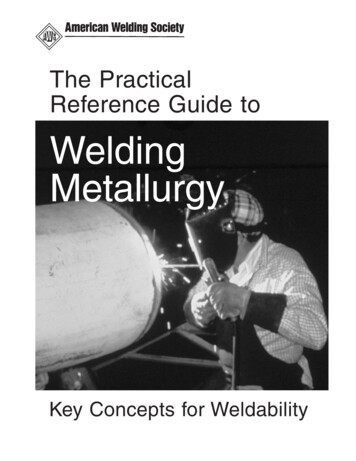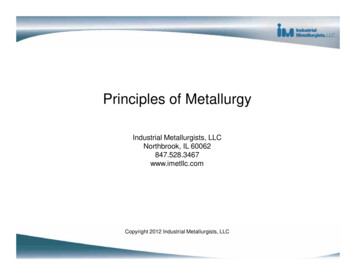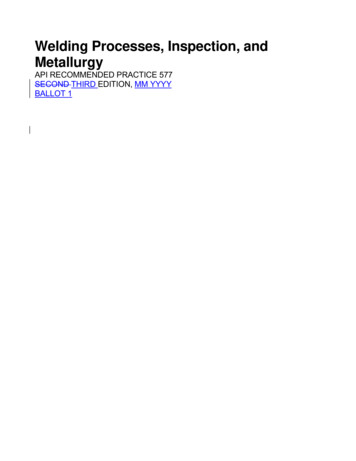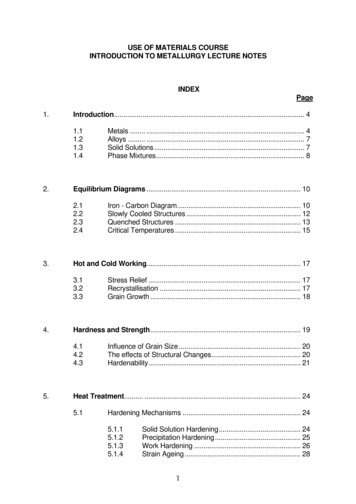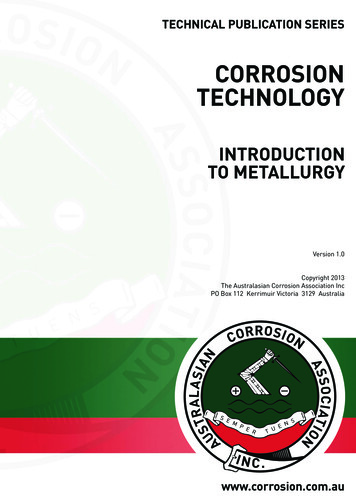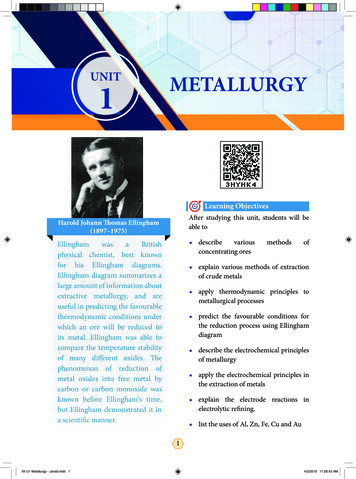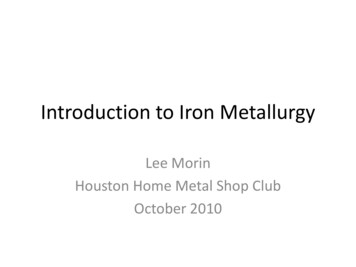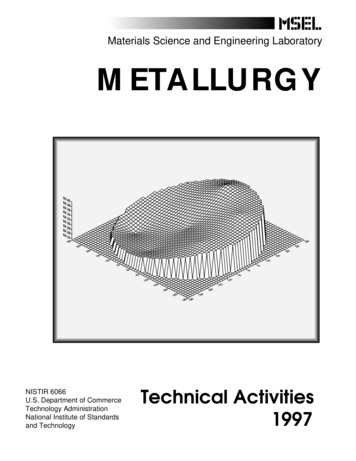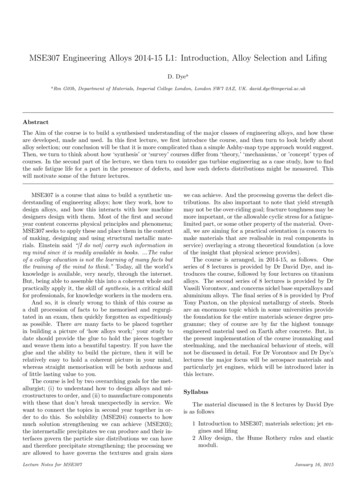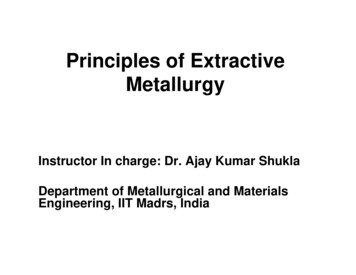
Transcription
Principles of ExtractiveMetallurgyInstructor In charge: Dr. Ajay Kumar ShuklaDepartment of Metallurgical and MaterialsEngineering, IIT Madrs, India
Learning objectives of thecourse Knowledge of various techniques, unit process and operationsused in metal extraction and refining. To apply the fundamental knowledge for design of a reactorand process flow sheets. To develop computational and mathematical abilities to beapplied for process design and control. It may be C ,MATLAB, Excel-Solver, FlowBal, FactSage or any otherlanguage of interest. To be able to select the correct process routes, reactors and beable to optimize and control them. To develop the leaders for coming future who are able to bringnew and economic technologies for metal extraction.
Text books:1.Principles of Extractive Metallurgy, Terkel Rosenqvist, McGraw-Hill BookCompanyPrinciples of Extractive Metallurgy, H. S. Ray and A. Ghosh, WEL PublishingExtractive Metallurgy of Copper, W.G. Davenport, A.K. Biswas, PERGAMONpublishing companyHandbook of Extractive Metallurgy: Fathi Habashi; Wiley-VCH2.3.4. Marks distribution (All exam problems will be computational innature)1.2.3.4.5.Quiz 1: 10%Quiz 2: 10%Assignments: 20%Term project: 10%Final Exam: 50% AssignmentsOne every week. Students may use computer coding/techniques to solvethem. It is advised to solve the assignment problems by their own if want toperform well in exams. AttendanceThere is no weightage for the attendance.Since the course involves a lot of computational work andfundamental understanding about various principles whichwould be difficult to understand for those who miss theclasses. It would be in the interest of the all the students toattend all the classes if they want to score enough to passthe course.
What is Extractive Metallurgy ? Deals with extraction of metals from its naturally existing ore/mineralsand refining them Minerals: Inorganic compounds with more than one metal inassociation with non-metals like S,O,N etc. Naturally existing minerals are sulphides, oxides, halides like:Hematite (Fe2O3), Magnetite (Fe3O4), Chalcopyrite (CuFeS2), Dolomite(CaCO3.MgCO3) .list is endless. What are the sources of metals ? Earth Crust (Aluminum: 8.1%, Iron 5.1%, Calcium: 3.6%, Sodium:2.8%, Potassium: 2.6%, Magnesium: 2.1%, Titanium: 2.1%, Manganese:0.10%) Ocean water: ( Na: 10500 g/ton, Mg: 1270 g/ton, Ca: 400 g/ton, K: 380g/ton) ; Ocean nodules (Mn: 23.86%, Mg 1.66%, Al 2.86%, Fe 13.80%.) Recycled scrap (at the end of metals’ life)
Resources of metalcontaining minerals inIndia Abundant: Al, Be, Cr,Fe, Mn, Mg, Ti, Zr, Th,Pb and Zn, raw earthmetalsVery small: Co,Ni,Cu,Sn, Au, V, Ni,Cd and U.Poor or not found:Sb, Bi, Co, Hg, Mo,Nb, Ta, Sr, Se, Ag, W,Pt
Types of ores Oxide ores: Examples: Fe2O3, Fe3O4Apart from Fe, other heavy metals which are producedfrom oxide ores are:Manganese, Chromium, Titanium, Tungston, uraniumand Tin. Sulphide ores: Copper ore (CuFeS2, Chalcopyrite),sphalerite (Zn,Fe)S, Galena PbS, Pyrite FeS2.Others: Nickel, Zinc,Mercury and Molybdenum Halide ores: Rock salts of Sodium, Magnesium chloridein sea water
Commercial production of metals Availability of ore deposits Concentration of metal in the ore Availability of technology of extraction andrefining of that metal Physical and chemical properties of themetal Market demand of that metal Economy of the process: Readily available, Easily producedand available at low processing cost with desired properties
Some interesting facts The first metal produced was copper and bronze,produced by smelting copper and tin ores in charcoalfire. World production (yearly) Steel: 1400 MT, Aluminum: 40MT, Copper: 17 MT, Lead: 8 MT, Ni: 2 MT, Magnesium:1 MT, Ti: 0.15 MT Steel is the highly consumed material and its per capitaconsumption is the index of economic prosperity of anynation. Growth rate of metal production was highest during1950-1970. China exhibited very high growth rate in last ten years(182 MT in 2002 to 700 MT in 2011)
Unit processes and Unit operations Any metal extraction process is the combination ofsimilar and unique kind of steps known as Unitprocesses/unit operations. Unit operations: Physical operations like crushing,grinding, sizing, mixing through agitation, filteration,distillation, comminution Unit processes: Chemical processes like leaching,smelting, roasting,Electrolysis, decarburization,Dephosphorization, Degassing, Deoxidation etc.Combination of all unit steps/processes areresulting in Flow-Sheets
Flow sheetfor copperextractionprocess Crushing, Grinding,Floatation are unitprocesses Roasting, smelting,Blowing, Refining,Electrolysis are Unitprocesses
Flow sheet for iron and steelextraction process
Flow sheet for Zinc extraction process
Various reactors: a) Fixed bed reactor b) Shaft furnace c) Fluidizedbed d) Retort e) Rotary kiln f) Reverberatory furnace g) Electric arcfurnace h) Pneumatic/top blown converter
Classification of unit processes/operation by different criteria According to phases involved: Gas-Solid: Roasting, Gas reductionGas-liquid: steelmaking blowing/refining, DistillationLiquid-Liquid: Slag metal reactionsSolid-solid: Leaching, precipitation etc. According to equipments involved: Fixed bed: Sintering, percolation leachingFluidized bed: Fluidized roasting and reductionShaft furnace: Iron blast furnace, lime calcination kilnRotary kiln: Drying and calcinationRitort: Coke open, carbothermic zinc production, Mg production bypidgeonReverberatory furnace: Matte smelting (Cu etc.), open hearthsteelmakingElectric arc furnace: Steelmaking, matte smelting, ferro alloyproductionCell for salt fuse electrolysis: Production and refining of aluminiumCell for aqueous electrolysis: Electrolytic reduction and refining
Classification according to chemicalreactions: Oxidation: Roasting, sintering, LD steelmaking Reduction: Blast furnace ironmaking Slag metal reactions: Steelmaking, mattesmelting Chlorination: Titanium (converting totetrachloride) Electrolytic reduction: Zinc and Aluminumproduction Electrolyte refining: Refining of Copper andNickel
Classification based upon methodsof metal extraction Physical seperation/Mineral processingThe objective is to concentrate the metallic content in the ore,achieved by a series of comminition (crushing and grinding),screening and seperation process PyrometallurgyIt involves the smelting, converting and refining of metal concentrate. HydrometallurgyIt involoves the precipitation of metal in an aqueous solution. ElectrometallurgyElectrolysis process to extract metal. Electrowinning: Extraction of themetal from electrolyte; Electrorefining: Refining of impure metals inthe form of an anode.Majority of metals are extracted by pyrometallurgicalroute because it is fast, easily adaptable and cheaper
Principles you must know ? Heat and mass balance : to know the material requirement Thermodynamics : Feasibility criteria Kinetics and rate of process: How long it take to complete theprocess Heat transfer: For improving the thermal efficiency of theprocess Fluid dynamics: To know the mixing of the reactor High temperature properties of metals/slag: To know thephysical properties of various phases, their mobility and role inmetal refining processes. Electrochemistry: To estimate, overpotential, current efficiency Hydrometallurgy: Eh-pH diagram, rate estmation of leachingprocess
cess:Size reduction ofmineralBy crushing/grindinga)Jaw crusherb)Roll crusherc)Gyratory crusherd)Cone crushere)Hammer millf)Ball mill
Screening: Sieve analysisFiner particles arecollected in lowerboxes
Classification process: Due to different size, shapeand densities, materials are classified in fluids/water.It depends upon following factors:1. Smaller particles fall more slowly in fluids than dolarger ones (stokes law)2. In cyclonic movement (hydrocyclone), centrifugalforce have larger influence on larger size particlesthan smaller ones.3.Small particles having low intertia behaves likesuspended medium.4.Larger particles require higher velocity for seperation.Classifiers: 1. simple Box Classifier2. Bowl/rake clasifier3. Hydro cyclones
a) Simple sluice box classifierb) Bowl/rake classifierHydrocyclone
Separation process (Froth Floatation)Due to different surface free energies of the differentminerals, there is selective adsorption on to the air bubbles Frothers: To stabilize the air bubbles Collectors: Selective adsorption by lowering interfacial enegies. Modifying agents: Intensify the collector performncea) front view b) side view
Agglomeration process: Example : Sintering of iron ores)Moving bed of fine iron ore ( 6 mm), mixed with coal fines(5-6%, as a fuel and water (10-12%, for permeability) isignited for agglomeration of oxide and sulphide fines.
Pyrometallurgy: High temperatureprocesses Calcination: Thermal treatment of an oreto decompose and eleminate the volatileproducts (like CO2, water)Example: CaCO3(s) CaO (s) CO2 (g)Feasible tempearture for above reaction is910 C (at partial pressure of 1 atm.)Calination temperatures for others:MgCO3: 417 C, MnCO3: 377 C, FeCO3:400 C
Roasting: Involves heating of ores belowfusion point to in excess of air It is of three types: Oxidizing roast: to oxidise sulphur insulphide ores:PbS 1.5 O2 PbO SO2 Volatilizing roast: To remove volatile oxideslike ZnO, As2O3, Sb2O3 etc. Chloridizing roast: To convert metalcompounds to chlorides to be reduced later:2NaCl (s) PbS (s) 2O2(g) Na2SO4(s) PbCl2
Smelting: It is aprocess for theproduction ofmetal/metal rich phaseknown as ‘matte’ alongwith gangue known as‘slag’ Reduction of metaloxide ore is done bysmelting process:MO (s,l) C (s) M (s,l) CO (g)MO (s,l) CO (g) M(s,l) CO2 (g)Example: Blast furnacefor ironmaking
Carbothermic reduction: Examples:Fe,Sn,Pb,Zn,Ferroalloys Carbothermic reduction of iron ore (Hametite) inblast furnace is a well known process. Overallprocess is written as: Ironore oxide mineral gangue Reducer (C) flux hot blastoxygen enriched air Pig iron (liquid) Slag (liquid) wastegas (CO,CO2,N2)Iron ore contains Fe2O3, along with gangue materials such asSiO2, Al2O3.Charge materials are: Iron ore limestone (flux) CokeOutput ispig iron (1300 C), 4.5% C, 0.4-0.6% Si, 0.1-0.2% P, 0.040-0.050%S, 0.1-0.5% MnSlag: CaO/SiO2 1.1; CaO 30-40%; Al2O3 10-23%; FeO 1%; MgO 8%Waste Gas: CO 20-25%, CO2 20-25%, rest N2
Blast furnace layout with auxillaryequipments
Reaction zones in a blast furnace
a) Gas temperature along stackb) Reduction zones along stackc) Carbon reduction degree (O/Fe) with stack height
Chemical reactions in a blastfurnace Zone 1 ( 950 C),upper zone of stack, reduction of Fe2O3,Fe3O3 takesplace:3Fe2O3(s) CO 2Fe3O4(s) CO2Fe3O4(s) CO 3FeO(s) CO2 Zone 2 (950-1000 C), chemical reserve zone, FeO is in equilibrium withgaseous phase:FeO(s) CO Fe(s) CO2 Zone 3: (950 T 1050 C), the reduction of FeO by rising CO gas takesplace:FeO(s) CO Fe CO2 Zone 4: ( 1000-1050C), direct reduction of FeO to carbon takes place. Reaction in raceway zone: C O2 CO2followed by CO2 C 2CO (Boudward reaction)OverallC O2 2COBoudward reaction is thermodynamically feasible at T 1050 (belowzone 4). It supports the conversion of CO2 to CO in raceway and boshregion where T 1050 C.
Metallothermic reduction Thermite welding:Fe2O3(s) 2Al Al2O3(l) 2Fe(l) Ferroalloy production:Cr2O3 2Al 2Cr(l) Al2O3(l) Titanium production by Kroll’s process:TiCl4(l) 2Mg 2MgCl2(l) Ti(s) Solid state reduction of oxides:Tungston: WO3(s) 3H2 W(s) 3H2OIron: Fe2O3 3H2 2Fe 3H2O
Low pressure/high pressurepyrometallurgical processes Low pressure process Magnesium extraction process: 2MgO.CaO(s) Si (as Fe-Si)(s) 2Mg(g) 2.CaO.SiO2 FeThis reaction moves in right direction at lowpressures.Vacuum degassing of steels:[C] [O] {CO} High pressure processZrO2(s) 2Ca(g) Zr(s) 2CaO (s)
Extraction of metals from sulphideores (Examples: Cu,Ni,Zn,Pb) Extraction of lead Lead ore consists of PbS (galena) along with Sphalerite(ZnS),Pyrite(FeS2),Cu2S and some precious metals like gold and silver asgangue.First of all lead ore (3-10% lead) is concentrated to 60-70% by froth floation,then roasted to remove sulpher and form oxides, followed by reduction inblast furnace using coke. Extraction of Zinc Zinc ore consists of Sphalerite (ZnS) along with sulphides of copper, leadand cadmium with some precious metals as gangue.First of all sulphide is converted to oxide by roasting process, followe bycarbothermic reduction:ZnO(s) C (s) Zn(g) CO(g).vacuum needed to push reaction if forwarddirection.
Extraction of copper The copper ore is known as Chalcopyrite (CuFeS2).Copper is less than 2%, which is concentrated byfroth floatation. Roasting of chalcopyrite is done to remove ironsulphide in the form of FeO.2CuFeS2(s) O2(g) Cu2S 2FeS SO2(g)FeS 1.5.O2(g) FeO(s) SO2(g) Roasted ore is charged into a reverberatoryfurnce/flash smelting unit along with Silica (SiO2) asa flux. Output of the furnace is matte (Cu rich liquid melt)along with FeO.SiO2 slag. Matte and slag are easilyseperable.
Converting of Cu-matte in PierceSmith converter It involves air oxidation of molten matte received fromsmelting. It involves two step process:(a) FeS removal and slag formation:2FeS (l) 3O2 SiO2 2.FeO.SiO2(l) 2.SiO2(g)Process temperature: 1200 C(b) Blister copper ( 99% Cu) formation stage:Cu2S O2 2Cu SO2 (g)Point to be noted: Cu loss in slag starts after sulpher inmatte falls below 0.02%Copper conversion does not start till Fe in matte isbelow 1%.
Pierce-Smith Converter
Extraction of reactive metal byhalide route Extraction of Titanium Titanium ore exists in the form of oxide (Rutile,TiO2) or Ilmenite (FeO.TiO2). As a first step TiO2 is chlorinated at 900 C:TiO2 (s) C(s) 2Cl2(g) TiCl4 (g) CO2 (g) TiCl4 is removed by selective distillation,followed by reduction of TiCl4 by Magnesium,known as Kroll’s process.TiCl4(l) 2Mg(l) 2MgCl2(l) Ti (s)
Refining process Oxidation to remove C,Si,P,Mn etc(steelmaking) Sulphidation to remove :Cu,Ni.Co fromlead; Cu from tin etc. Chlorination to remove Zn from lead;Zn,Cu and Pb from bismuth Electrochemical method by cathodicdeposition; examples:Cu,Ag,Au,Ni,Co,Pb,Sb,Bi etc.
Oxygen Steelmaking process forrefining of pig ironSelective oxidation of C,Si,Mn,P,Fe with the help of highspeed oxygen blow. Process done in a basic lined vesseland Lime added as slag former to combine SiO2. Oxidizingand enough volume of slag is formed to promotephosphorous removal. Process generates a lot of heat ofoxidation which is compensated by iron ore/scrap additionsas a coolant.
Next Class task: Material and heat balance of processes. Come prepared with Solver modelapplying MS-Excel Flow-Bal software will be introduced andstudent groups will be formed.
What is Extractive Metallurgy ? Deals with extraction of metals from its naturally existing ore/minerals and refining them Minerals: Inorganic compounds with more than one metal in association with non-metals like S,O,N etc. Naturally existing minerals are sulphides, oxides, halides like: Hematite (F
